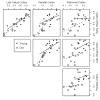Age differences in neural distinctiveness revealed by multi-voxel pattern analysis
- PMID: 20451629
- PMCID: PMC2962693
- DOI: 10.1016/j.neuroimage.2010.04.267
Age differences in neural distinctiveness revealed by multi-voxel pattern analysis
Abstract
Current theories of cognitive aging argue that neural representations become less distinctive in old age, a phenomenon known as dedifferentiation. The present study used multi-voxel pattern analysis (MVPA) to measure age differences in the distinctiveness of distributed patterns of neural activation evoked by different categories of visual images. We found that neural activation patterns within the ventral visual cortex were less distinctive among older adults. Further, we report that age differences in neural distinctiveness extend beyond the ventral visual cortex: older adults also showed decreased distinctiveness in early visual cortex, inferior parietal cortex, and medial and lateral prefrontal cortex. Neural distinctiveness scores in early and late visual areas were highly correlated, suggesting shared mechanisms of age-related decline. Finally, we investigated whether older adults can compensate for altered processing in visual cortex by encoding stimulus information across larger numbers of voxels within the visual cortex or in regions outside visual cortex. We found no evidence that older adults can increase the distinctiveness of distributed activation patterns, either within or beyond the visual cortex. Our results have important implications for theories of cognitive aging and highlight the value of MVPA to the study of neural coding in the aging brain.
Copyright © 2010 Elsevier Inc. All rights reserved.
Figures




References
-
- Baltes PB, Lindenberger U. Emergence of a powerful connection between sensory and cognitive functions across the adult life span: a new window to the study of cognitive aging? Psychology and Aging. 1997;12:12–21. - PubMed
-
- Brinley JF. Cognitive sets, speed, and accuracy of performance in the elderly. In: Welford AT, Birren JE, editors. Behavior, aging, and the nervous system. Thomas; Springfield, IL: 1965. pp. 114–149.
-
- Buckner RL, Snyder AZ, Sanders AL, Raichle ME, Morris JC. Functional brain imaging of young, nondemented, and demented older adults. Journal of Cognitive Neuroscience. 2000;2(12 Suppl):24–34. - PubMed
-
- Cabeza R. Hemispheric asymmetry reduction in older adults: The HAROLD model. Psychology and Aging. 2002;17:85–100. - PubMed
-
- Cabeza R, Anderson N, Locantore J, McIntosh A. Aging gracefully: Compensatory brain activity in high-performing older adults. NeuroImage. 2002;17:1394–1402. - PubMed
Publication types
MeSH terms
Grants and funding
LinkOut - more resources
Full Text Sources
Medical

